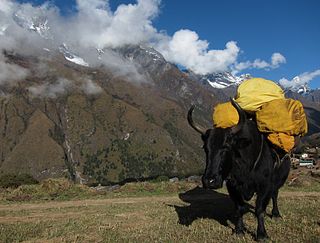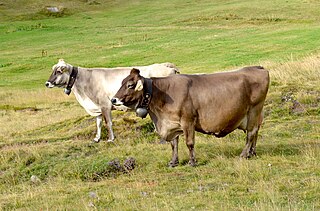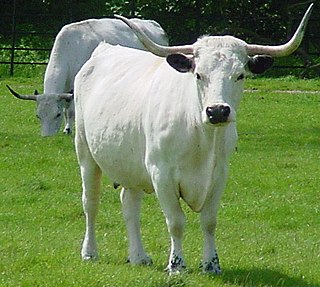Related Research Articles

Beefalo constitute a fertile hybrid offspring of domestic cattle, usually a male in managed breeding programs, and the American bison, usually a female in managed breeding programs. The breed was created to combine the characteristics of both animals for beef production.

A zebu, sometimes known as indicine cattle or humped cattle, is a species or subspecies of domestic cattle originating in the Indian sub-continent. Zebu are characterised by a fatty hump on their shoulders, a large dewlap, and sometimes drooping ears. They are well adapted to withstanding high temperatures, and are farmed throughout the tropical countries, both as pure zebu and as hybrids with taurine cattle, the other main type of domestic cattle. Zebu are used as draught and riding animals, dairy cattle, and beef cattle, as well as for byproducts such as hides and dung for fuel and manure. Some small breeds such as the miniature zebu are also kept as pets. In 1999, researchers at Texas A&M University successfully cloned a zebu.

The Red Poll is a dual-purpose breed of cattle developed in England in the latter half of the 19th century. The Red Poll is a cross of the Norfolk Red beef cattle and Suffolk Dun dairy cattle breeds.

A dzo is a hybrid between the yak and domestic cattle. The word dzo technically refers to a male hybrid, while a female is known as a dzomo or zhom. In Mongolian, it is called a khainag (хайнаг). There is also the English language portmanteau term of yattle, a combination of the words yak and cattle, as well as yakow, a combination of the words yak and cow.

A breed is a specific group of domestic animals having homogeneous appearance (phenotype), homogeneous behavior, and/or other characteristics that distinguish it from other organisms of the same species. In literature, there exist several slightly deviating definitions. Breeds are formed through genetic isolation and either natural adaptation to the environment or selective breeding, or a combination of the two. Despite the centrality of the idea of "breeds" to animal husbandry and agriculture, no single, scientifically accepted definition of the term exists. It was shown by set-theoretic means that for the term breed an infinite number of different definitions, which more or less meet the common requirements found in literature, can be given. A breed is therefore not an objective or biologically verifiable classification but is instead a term of art amongst groups of breeders who share a consensus around what qualities make some members of a given species members of a nameable subset.

Breeding back is a form of artificial selection by the deliberate selective breeding of domestic animals, in an attempt to achieve an animal breed with a phenotype that resembles a wild type ancestor, usually one that has gone extinct. Breeding back is not to be confused with dedomestication.

The Brahman is an American breed of zebuine-taurine hybrid beef cattle. It was bred in the United States from 1885 from cattle originating in India, imported at various times from the United Kingdom, from India and from Brazil. These were mainly Gir, Guzerá and Nelore stock, with some Indu-Brasil, Krishna Valley and Ongole. The Brahman has a high tolerance of heat, sunlight and humidity, and good resistance to parasites. It has been exported to many countries, particularly in the tropics; in Australia it is the most numerous breed of cattle. It has been used in the creation of numerous taurine-indicine hybrids, some of which – such as the Brangus and Brahmousin – are established as separate breeds.

The Nguni is a cattle breed indigenous to Southern Africa. A hybrid of different Indian and later European cattle breeds, they were introduced by Bantu-speaking tribes to Southern Africa during their migration from the North of the continent.

A crossbreed is an organism with purebred parents of two different breeds, varieties, or populations. Crossbreeding, sometimes called "designer crossbreeding", is the process of breeding such an organism, While crossbreeding is used to maintain health and viability of organisms, irresponsible crossbreeding can also produce organisms of inferior quality or dilute a purebred gene pool to the point of extinction of a given breed of organism.

Beefmaster is a breed of beef cattle that was developed in the early 1930s by Tom Lasater, from a systematic crossing of Hereford cows and Shorthorn cows with Brahman bulls. The exact mixture of the foundation cattle is unknown, but is thought to be about 25% Hereford, 25% Milking Shorthorn and 50% Brahman. It was first recognized by the USDA as a new breed in 1954. The original intention was to produce cattle that could produce economically in the difficult environment of South Texas. The cattle were selected by using the Six Essentials – weight, conformation, milking ability, fertility, hardiness and disposition. While brownish-red is the most common color, the breed has no color standards. Over the past decade, the Beefmaster breed has become very popular among herd managers using the breed in their heterosis programs for hybrid vigor. These cattle are a versatile breed and adapt to many climates.
The Brangus is an American hybrid breed of beef cattle derived from cross-breeding of American Angus and Brahman stock. Registered animals have 5/8 Angus and 3/8 Brahman parentage. A similar hybrid breed, the Australian Brangus, was separately developed in Australia from about 1950.

The Limousin, French: Limousine, is a French breed of beef cattle from the Limousin and Marche regions of France. It was formerly used mainly as a draught animal, but in modern times is reared for beef. A herd book was established in France in 1886. With the mechanisation of agriculture in the twentieth century, numbers declined. In the 1960s there were still more than 250 000 head, but the future of the breed was not clear; it was proposed that it be merged with the other blonde draught breeds of south-western France – the Blonde des Pyrénées, the Blonde de Quercy and the Garonnaise – to form the new Blonde d'Aquitaine. Instead, a breeders' association was formed; new importance was given to extensive management, to performance recording and to exports. In the twenty-first century the Limousin is the second-most numerous beef breed in France after the Charolais. It is a world breed, raised in about eighty countries round the world, many of which have breed associations.

The Welsh Black is a dual-purpose breed of cattle native to Wales. This breed is one of the oldest in Britain, going back to pre-Roman times. The Welsh Black was a prized possession of Britain's people upon the invasion of the Saxons.

The White Park is a rare breed of ancient horned cattle primarily residing in Great Britain. Two similar semi-feral populations, the Chillingham Wild Cattle in Northumbria and the Vaynol cattle from Gwynedd in North Wales, have a separate breed status. There are relatively small numbers of the White Park cattle in the United States, where they are commonly known as the Ancient White Park in order to distinguish them from the American White Park, which is a population of the British White breed.

The Droughtmaster is an Australian breed of beef cattle. It was developed from about 1915 in North Queensland by crossing zebuine cattle with cattle of British origin, principally the Beef Shorthorn. It was the first Australian taurindicine hybrid breed; it is approximately 50% Bos indicus and 50% Bos taurus.

Philippine cattle are the indigenous cattle breed found throughout the Philippines. It is a small breed with mature bulls weighing about 400 kg and mature cows weighing about 300 kg. The color ranges from grey to brown to fawn, with white spotting on some animals. The females are humpless, while males have a low hump. The breed is used for draught work and milk and beef production, although carabao are often preferred for draught work. Four breed types have been recognized, the Ilocos in northwestern Luzon, Batangas in southwestern Luzon, Iloilo on Panay island, and Batanes Black on the Batanes Islands between Luzon and Taiwan.
The American Breed is an American bovid hybrid of cattle with a small percentage of American Bison blood. It was developed in the 1950s by a New Mexico rancher looking for beef cattle which could survive on poor fodder in the arid Southwest.

The Argentine Criollo is one of the Criollo type cattle found in the Americas. Criollo cattle are descended from the first bovines brought by Christopher Columbus in his travels to America. These cattle are known for their docility and workability in addition to tremendous genetic variability. Like their Criollo relatives, the Argentine Criollo exhibits the full range of Bos taurus color patterns. These animals are highly adapted to their environment due to feral - naturally selective breeding regimes over the past 500 years, therefore they are extremely desirable for crossbreeding with traditional European breeds to assure incredible hybrid vigor. The Asociación Argentina de Criadores de Ganado Bovino Criollo was established in 1990 as the official breed society. Owners who wish to register their livestock with the Criollo Association must have their cattle tested and examined for pureness of origin, before they can be considered purebred Argentine Criollo cattle.

The American Angus is an American breed of beef cattle. It derives from the Scottish Aberdeen Angus population, but may only be black. Red-coated individuals may not be registered with the American Angus Association, but can be registered as Red Angus.